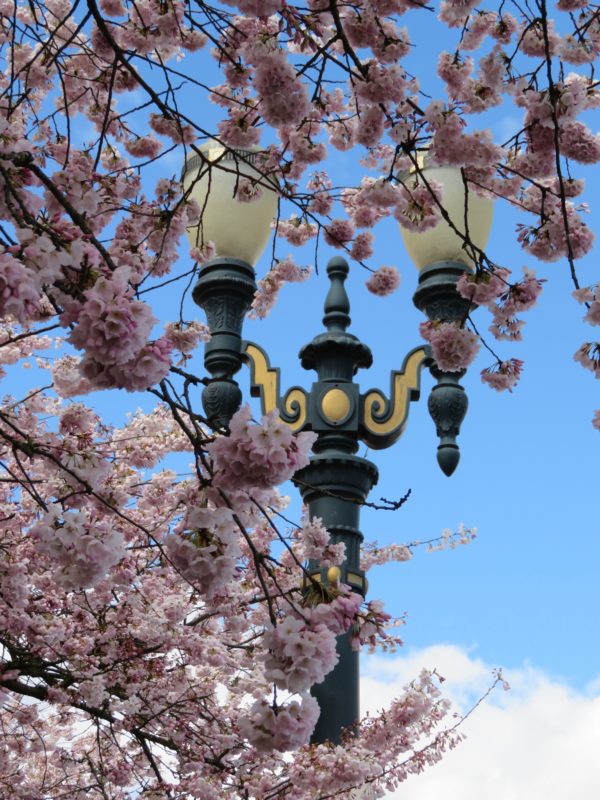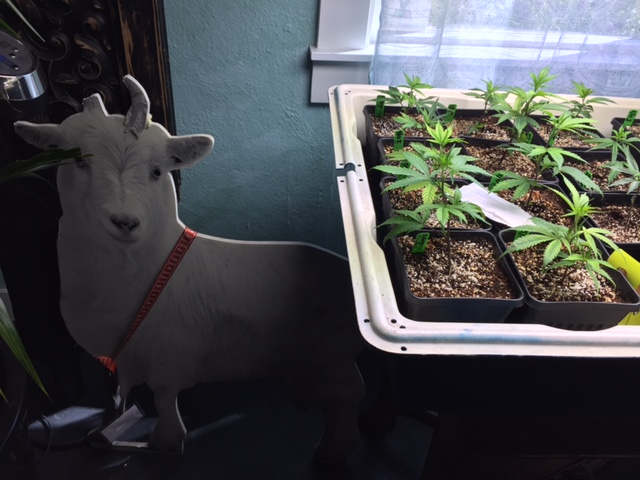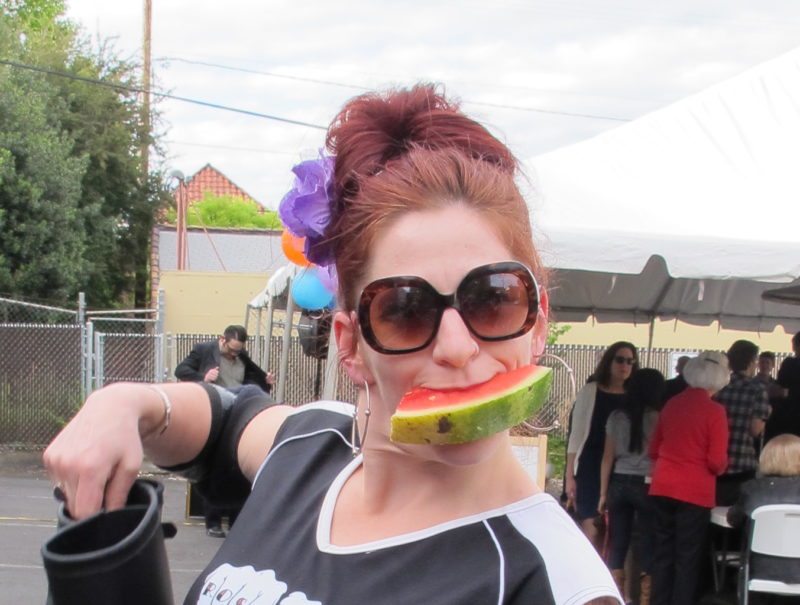If you walk along Portland’s waterfront park right now the wind and rain will often make the air around you twirl with petals of cherry blossoms. The area around the Japanese American Plaza – commemorating the internment of the Japanese during WW II – is filled with blooming cherry trees that were imported from Japan, a gift of the Japanese Grain Importers Association, planted 28 years ago.
Giving these trees as a gift is not a new tradition – after all, in 1912 Washington D.C. received 3000 of them as an expression of goodwill from Japan. 5 years ago, Takamichi Okabe, Consul-General of Japan at that time in PDX, explained: “Sakura [cherry] is one of the most beloved flowers in Japan… it is a symbol of Japanese sensitivity of natural beauty, and it is also a symbol of the friendship between the U.S. and Japan.”
Large numbers of blossoms, then, matched by an almost equally large number of photographers. This weekend you could not walk amongst the trees at the north end of the parkway without bumping into someone with iPhone or camera.
At the south end of the parkway it was a completely different scene. Potluck in the Park set up their free Sunday meal under the ramp of the Hawthorne Bridge, with endless lines of the homeless waiting to get something to eat. The Non-Profit has been fighting hunger even before those cherry trees were planted – since 1991 nobody in Portland needs to go without a warm meal on Sundays – the numbers of people fed on that day range between 400 and 600, all based on donations and volunteers who provide the food and serve. They lost their original space at O’Bryant Square and so the off ramp of a bridge has to do.
I got to talk to a relatively young woman who had decorated her place setting on a fence post above the river with flowers. She had her walking (and defense) stick adorned with found objects to make it beautiful. A poignant expression of creativity thriving amidst all the adversity.
Large numbers of tears suppressed, when I walked away, feeling privileged as hell. This really was the weekend for crying – during the marches, when hearing the speeches, when seeing the homeless scurry, regardless of what they left behind, to quell their hunger.
The skies agreed, ready to let the drops fall. In large numbers.














































 “Marston was a man of a thousand lives and a thousand lies. “Olive Richard” was the pen name of Olive Byrne, and she hadn’t gone to visit Marston—she lived with him. She was also the niece of Margaret Sanger, one of the most important feminists of the 20th century. In 1916, Sanger and her sister, Ethel Byrne, Olive Byrne’s mother, had opened the first birth-control clinic in the United States. They were both arrested for the illegal distribution of contraception. In jail in 1917, Ethel Byrne went on a hunger strike and nearly died.
“Marston was a man of a thousand lives and a thousand lies. “Olive Richard” was the pen name of Olive Byrne, and she hadn’t gone to visit Marston—she lived with him. She was also the niece of Margaret Sanger, one of the most important feminists of the 20th century. In 1916, Sanger and her sister, Ethel Byrne, Olive Byrne’s mother, had opened the first birth-control clinic in the United States. They were both arrested for the illegal distribution of contraception. In jail in 1917, Ethel Byrne went on a hunger strike and nearly died. Byrne stayed home and raised the children. They told census-takers and anyone else who asked that Byrne was Marston’s widowed sister-in-law. “Tolerant people are the happiest,” Marston wrote in a magazine essay in 1939, so “why not get rid of costly prejudices that hold you back?” He listed the “Six Most Common Types of Prejudice.” Eliminating prejudice number six—“Prejudice against unconventional people and non-conformists”—meant the most to him. Byrne’s sons didn’t find out that Marston was their father until 1963—when Holloway finally admitted it—and only after she extracted a promise that no one would raise the subject ever again.“
Byrne stayed home and raised the children. They told census-takers and anyone else who asked that Byrne was Marston’s widowed sister-in-law. “Tolerant people are the happiest,” Marston wrote in a magazine essay in 1939, so “why not get rid of costly prejudices that hold you back?” He listed the “Six Most Common Types of Prejudice.” Eliminating prejudice number six—“Prejudice against unconventional people and non-conformists”—meant the most to him. Byrne’s sons didn’t find out that Marston was their father until 1963—when Holloway finally admitted it—and only after she extracted a promise that no one would raise the subject ever again.“




